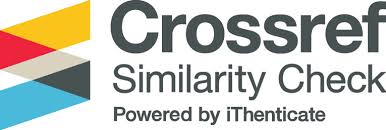The Analysis Effectivity of Two Antihypertensive Drugs Combination for Hypertension Outpatients in Karanganyar District Hospital
Abstract
The aim of hypertension treatment was to manage and control blood pressure so that the risk of cardiovascular disorders and other complications can be minimized. Blood pressure control can be achieved faster with combination treatment than monotherapy. The use of drugs combination was more effective than inertia therapy and prevented the risk of cardiovascular damage. The purpose of this study was to analyze the effectiveness of combination therapy of 2 drugs that have the highest target achievement for controlling blood pressure in patients with hypertension age ≥ 60 years is <150/90 mm Hg, for patients <60 years is <140/80 mm Hg.
The design of this study was retrospective and observational analytic with a cross-sectional approach. Data collection was conducted by reviewing the record of patients. The study samples were outpatients in Karanganyar District Hospital who suffer from hypertension and received the same drug combination therapy for three months successively. The patient's blood pressure was measured during inspection every month. The number of samples in this study was 59 respondents.
The results showed that the combination of two antihypertensive drugs most widely used by the CCB + ARB group with achievement target by 92.3% and the lowest achievement target from the combination of diuretic + ARB groups by 20%. The P-value of this research is 0.001 indicated that there were significant differences in the selection of an antihypertensive combination of 2 drugs.
References
(2) Riskesdas 2018. Hasil utama riskesdas kemenkes RI. Badan Penelitian dan Pengembangan Kesehatan. http:kesmas.kemkes.go.id/assets/upload/dir_519d41d8cd98f00/files/Hasil-Riskesdas.2018-1274
(3) Laporan provinsi jawa tengah Riskesdas 2018. Badan Penelitian dan Pengembangan Kesehatan 2019. Jakarta. http: dinkesjatengprov.go.id/v2018/storage/2019/12/cetak-laporan-riskesdas-jateng-2018-acc-pimred.pdf
(4) James PA, Oparil S, Carter BL, Cushman WC, Dennisin-Himmelfarb C, Handler J, et al. 2014. Evidence Based Guideline For the Management of High Blood Pressure in Adult: Report from the Panel Members Appointed ti the Eight Joint National Commitee (JNC 8). JAMA 311:507-520. DOI: 10.1001/jama.2013.284427
(5) Vrijens B, Antonius S, Burrier M, Sierra A, and Volpe M. 2017. Current situation of medication adherence in hypertension. Front,Pharmachol 8:100. DOI: 10.3389/fphar.2017.00100
(6) Mancia G, Rea F, Corrao G, Grassi G. 2019. Two drug combinations as first step antyhipertensive treatment. Ahajournal. 2019;124:1113-1123. DOI:10.1161/CIRCRESAHA.118.313294.
(7) Baroroh F, Sari A, Masruroh N. 2019. Cost effective analysis of candesartan therapy in comparison to candesartan-amlodipine therapy on hypertensive outpatients. Open access maced J Med Sci. 2019;7(22):3837-3840. DOI:10.3889/oamjms.2019.515
(8) Ina Heart. 2019. Sebenarnya berapa tekanan darah normal pada lansia. http: www.inaheart.org/education-for-patient.
(9) Rea F, Corrao G, Merlino L, Mancia G. 2018. early cardiovascular protection by initial two drug fixed dose combination treatment vs monotherapy in hypertension. EurHeartJ. 2018;39:3654-3661. DOI:10.1093/eurheartj/ehj-420
(10) Kandarini Y. 2017. Tatalaksana farmakologi terapi hipertensi. Divisi ginjal dan hipertensi. Bagian SMF ilmu penyakit dalam FK.Unud/ RSUP Sanglah Denpasar. Trigonum sudema-ilmu penyakit dalam XXV hlm. 44-61. http:simdos.unud.ac.id/uploads/file.penelitian.1.dir/91ce253ff5aa007ba1cc8d5d19cfe3f4.pdf.
(11) Muhadi. 2016. JNC 8: Evidence-based guideline penanganan pasien hipertensi dewasa. Divisi kardiologi, Fakultas Indonesia/RS Cipto mangunkusumo. Jakarta
(12) Johnson RJ, Feehally J, Floege J. 2015. Comprehensive Clinical Nephrology. 5th edition. Elseiver Saunders; Philadelpia
(13) Baroroh F, Sari A. 2017. Analisis efektivitas biaya pengobatan kombinasi candesartan-amlodipine dibandingkan dengan kombinasi candesartan-diltiazem pada pasien rawat jalan. J Pharmacy 14:188-198. DOI: 10.30595/pharmacy.v14i2.1952
(14) Moran AE et al. 2015. Cost Effectiveness of hypertension therapy according to 2014 guidelines. New England Journal of Medicine 372:447-55.
(15) Widyantoro B. 2018. Perlukah kriteria hipertensi baru dan target pengendalian tekanan darah yang lebih agresif? Telaah paska studi SPRINT serta panduan ACC/AHA 2017 dan ESH/ESC 2017. Indonesian J cardiol. 2018;39:55-59. DOI:10.30701/ijc.v39i2.765













